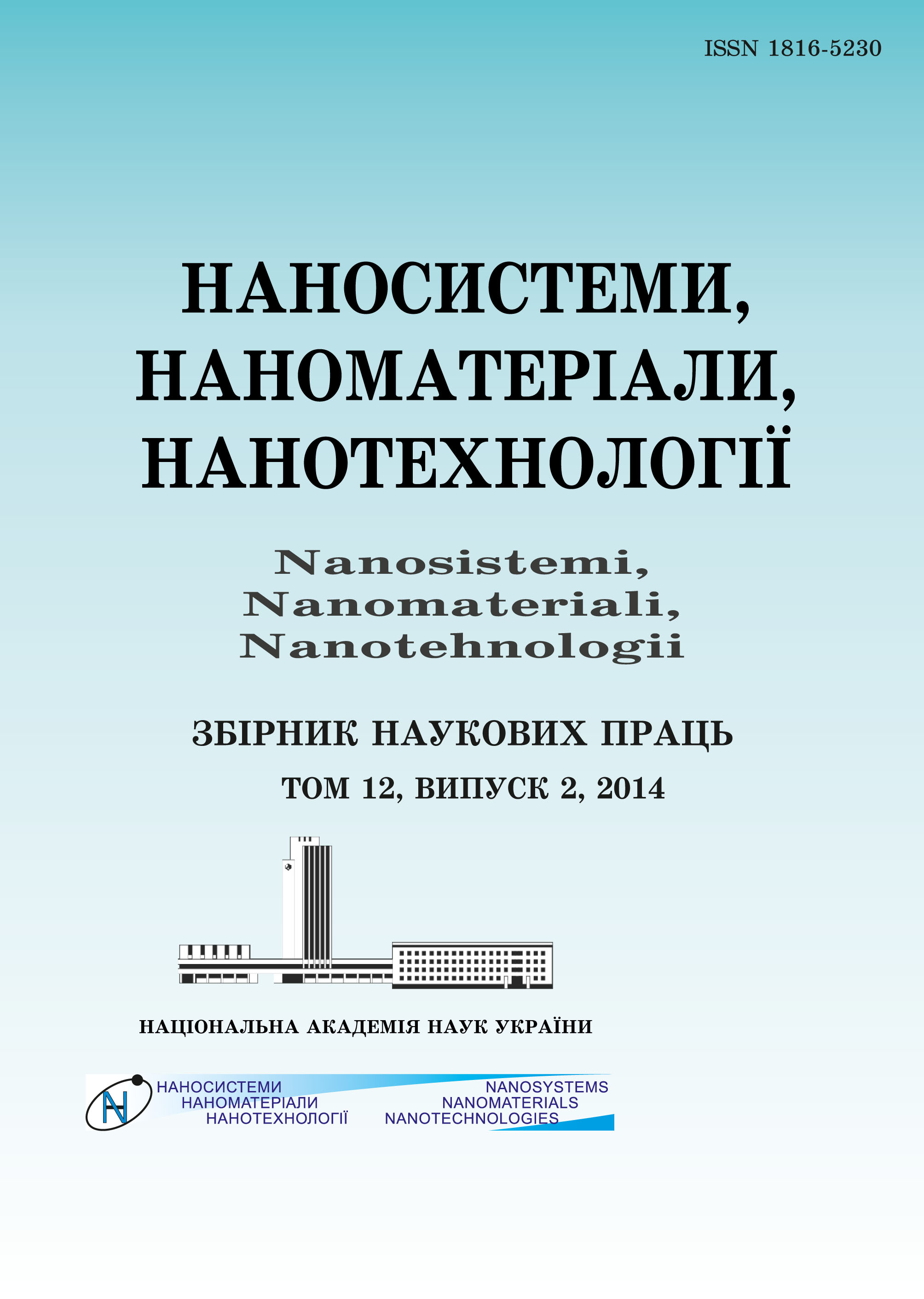|
|
|||||||||

|
Year 2024 Volume 22, Issue 2 |
|
|||||||
|
|||||||||
Issues/2024/vol. 22 /issue 2 |
|
V.V. ZAIKA, N.K. SHVACHKO, V.L. KARBIVSKYY, V.H. KASIYANENKO,
I.V. SUHENKO, and A.P. SOROKA
Nanostructured ZnO Thin Films Obtained by Radio
Frequency Magnetron Sputtering
229–238 (2024)
PACS numbers: 68.37.Hk, 77.55.hf, 78.20.Ci, 78.66.Nk, 79.60.Bm, 81.15.Cd, 82.80.Pv
The radiofrequency magnetron deposition method is used to fabricate nanostructured thin ZnO films. The scanning electron microscopy method is used to estimate the film thickness and to study its surface morphology. A homogeneous surface morphology without obvious foreign inclusions is observed, and the film thickness is estimated to be in the range of 267–272 nm. The obtained films exhibit a developed nanosurface featuring the formation of nearly spherical clusters with an average diameter ranging from 25 to 40 nm. As found, the films with a thickness of about 270.0 nm have good transparency in the visible range with values ranging from 60% to 85%, and the band gap of 3.31 eV is obtained using the Tauc method. An increase in the binding energy of the Zn2p and Zn3d levels in the film compared to ZnO powder is found by x-ray photoelectron spectroscopy (XPS) that indicates an outflow of electron density from zinc ions. The change in the ratio of oxygen atoms to zinc atoms on the surface and in the film volume is determined by the XPS method. The analysed XPS spectra of oxygen are decomposed into 3 components, the first of which corresponds to O2- ions in the ZnO matrix, the second corresponds to O2- ions in oxygen-deficient regions, and the third corresponds to adsorbed oxygen species and hydroxyl groups on the film surface. From the obtained valence-band spectra, it is found that the bottom of the valence band consists mainly of 3d zinc states, and the top of the valence band is determined by hybridised O2p and Zn4s states
KEY WORDS: magnetron sputtering, ZnO thin films, XPS, SEM, valence band, band gap
DOI: https://doi.org/10.15407/nnn.22.02.229
REFERENCES
- H. Liu, F. Zeng, Y. Lin, G. Wang, and F. Pan, Appl. Phys. Lett., 102, No. 18: 181908 (2013); https://doi.org/10.1063/1.4804613
- C. Tian, X. Chen, J. Ni, J. Liu, D. Zhang, Q. Huang, and X. Zhang, Solar Energy Materials and Solar Cells, 125: 59 (2014); doi:10.1016/j.solmat.2014.02.028
- B. Mehmood, M. I. Khan, M. Iqbal, A. Mahmood, and W. Al?Masry, Int. J. Energ. Res., 45, No. 2: 2445 (2020); https://doi.org/10.1002/er.5939
- L. Znaidi, Mater. Sci. Eng. B-Adv., 174, Nos. 1–3: 18 (2010); https://doi.org/10.1016/j.mseb.2010.07.001
- S. Shrikant, M. Paolo, O. Takafumi, Sh. Junichiro, N. Janne-Petteri, K. Maarit, M. Koji, L. Chaoyang, K. Toshiyuki, I. Ataru, and M.-L. Leopoldo, Thin Solid Films, 685: 180 (2019); https://doi.org/10.1016/j.tsf.2019.06.010
- A. K. Ambedkar, M. Singh, V. Kumar, S. Kumar, B. Singh, A. Kumar, and Y. Gautam, Surf. and Inter., 19: 100504 (2020); https://doi.org/10.1016/j.surfin.2020.100504
- Z. A. Wang, J. B. Chu, H. B. Zhu, Z. Sun, Y. W. Chen, and S. M. Huang, Solid Stat. Electron., 53, No. 11: 1149 (2009); https://doi.org/10.1016/j.sse.2009.07.006
- S. Sharma, S. Vyas, C. Periasamy, and P. Chakrabarti, Superlattice Microst., 75: 378 (2014); https://doi.org/10.1016/j.spmi.2014.07.032
- M. Loeza-Poot, R. Mis-Fern?ndez, I. Rimmaudo, E. Camacho-Espinosa, and J. L. Pe?a, Mat. Sci. Semicon. Proc., 104: 104646 (2019); https://doi.org/10.1016/j.mssp.2019.104646
- R. Al-Gaashani, S. Radiman, A. R. Daud, N. Tabet, and Y. Al-Douri, Ceram. Int., 39, No. 3: 2283 (2013); https://doi.org/10.1016/j.ceramint.2012.08.075
- D. K. Kim and H. B. Kim, J. Alloy Compd., 509, No. 2: 421 (2011); https://doi.org/10.1016/j.jallcom.2010.09.047
- V. P. Singh and Ch. Rath, RSC Adv., 5, No. 55: 44390 (2015); https://doi.org/10.1039/C5RA04767F
- NIST X-Ray Photoelectron Spectroscopy Database. NIST Standard Reference Database Number 20 (Gaithersburg, MD: National Institute of Standards and Technology: 2000), 20899; https://dx.doi.org/10.18434/T4T88K
- A. G. Joshi, S. Sahai, N. Gandhi, Y. G. R. Krishna, and D. Haranath, Appl. Phys. Lett., 96, No. 12: 123102 (2010); https://doi.org/10.1063/1.3354025
- N. Ikeo, Y. Iijima, N. Niimura, M. Sigematsu, T. Tazawa et al., Handbook of X-Ray Photoelectron Spectroscopy (Tokyo: JEOL Ltd: 1991).
- J. Tauc, Materials Research Bulletin, 3, Iss. 1: 37 (1968); https://doi.org/10.1016/0025-5408(68)90023-8
 This article is licensed under the Creative Commons Attribution-NoDerivatives 4.0 International License ©2003—2024 NANOSISTEMI, NANOMATERIALI, NANOTEHNOLOGII G. V. Kurdyumov Institute for Metal Physics of the National Academy of Sciences of Ukraine. E-mail: tatar@imp.kiev.ua Phones and address of the editorial office About the collection User agreement |